Charles E W Bean, Diaries, AWM38 3DRL 606/228/1 - Folder - Part 3
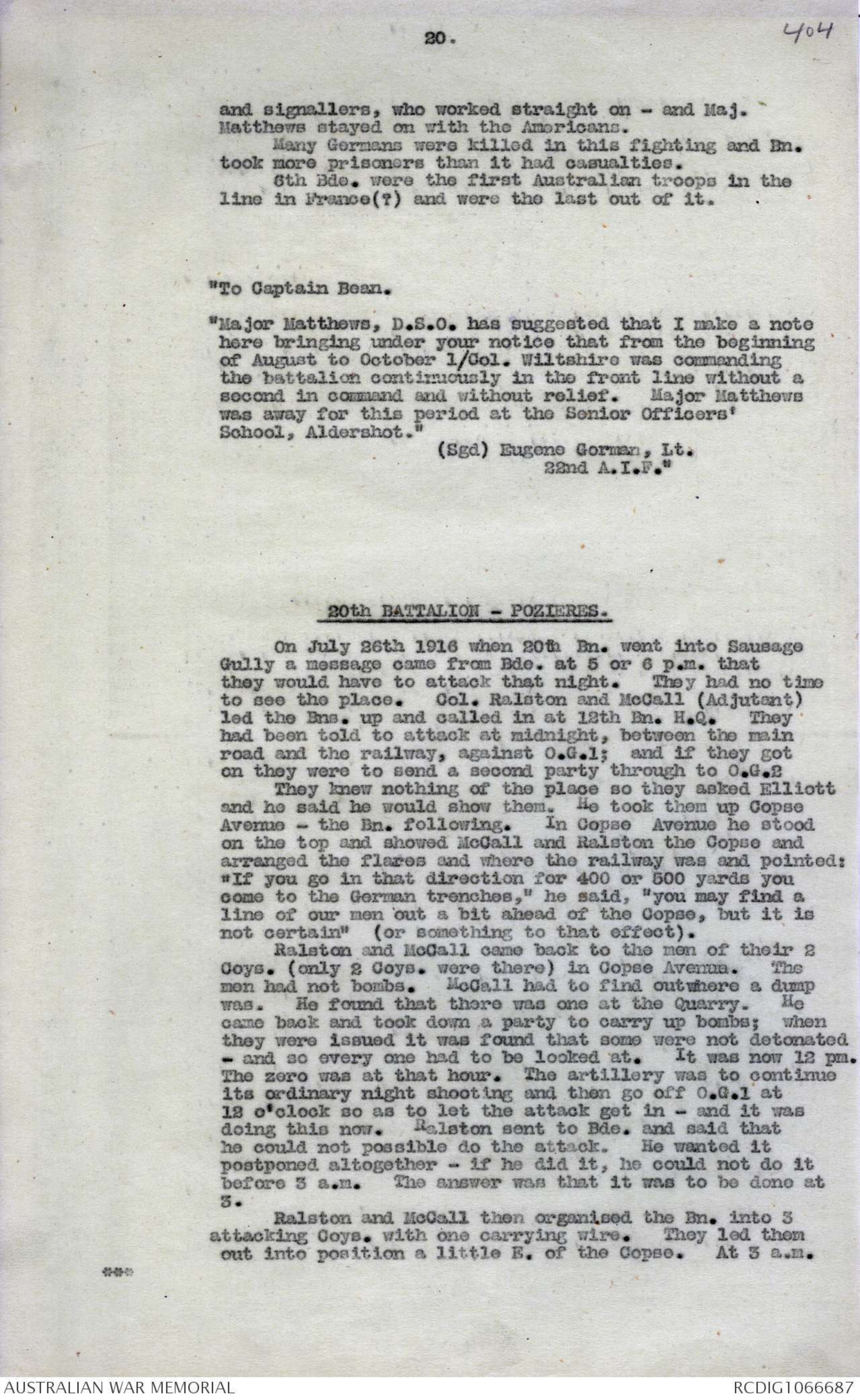
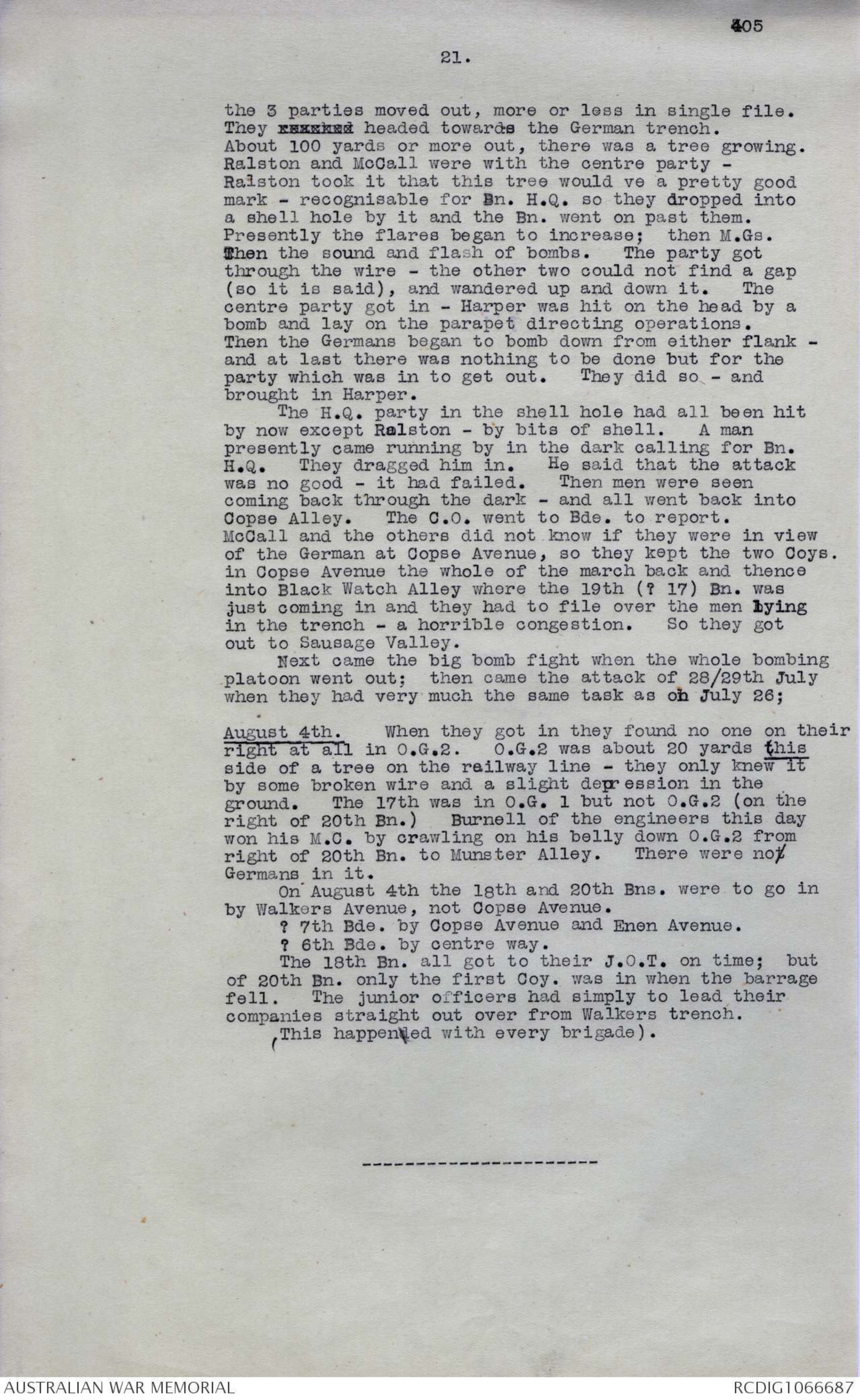
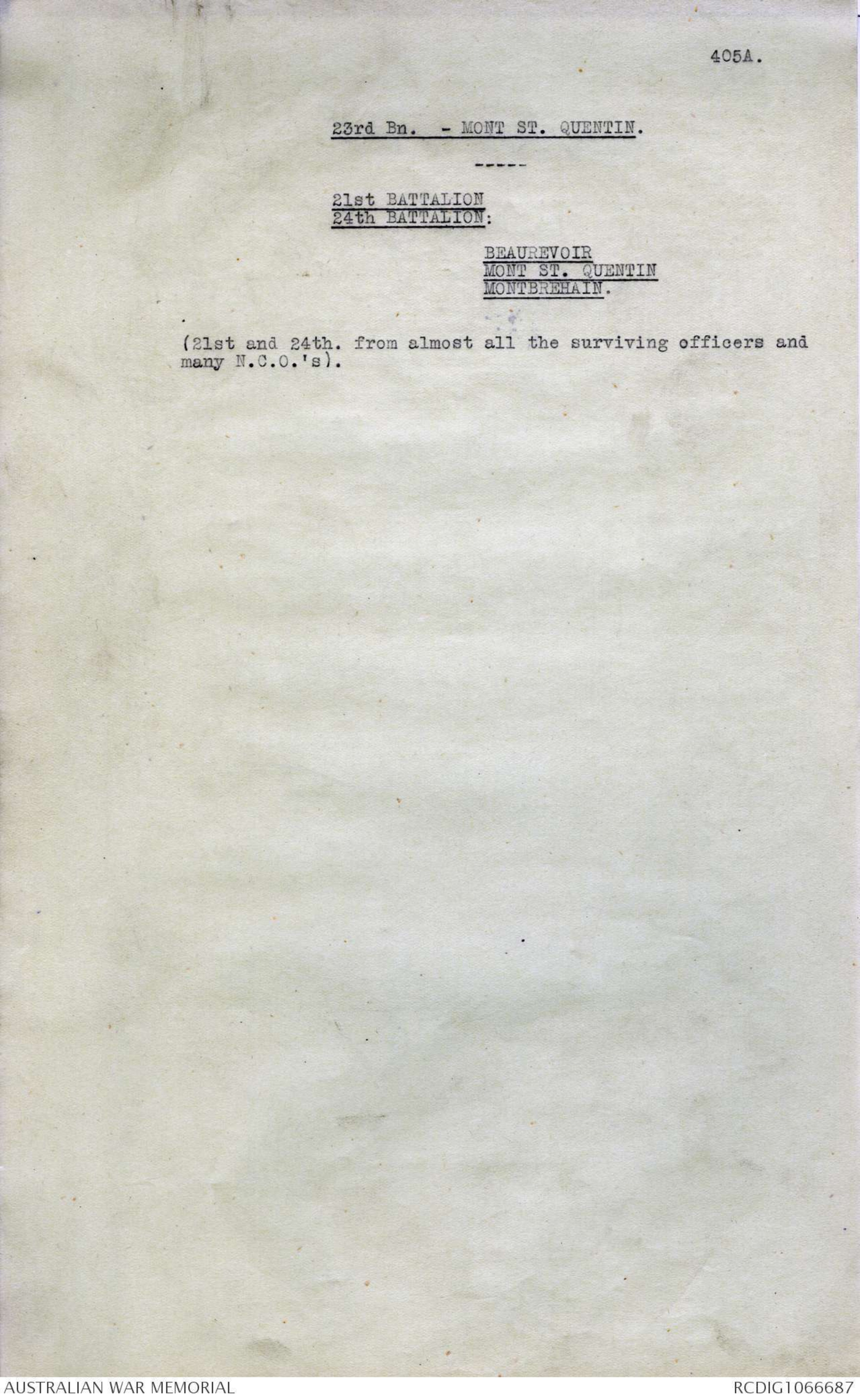
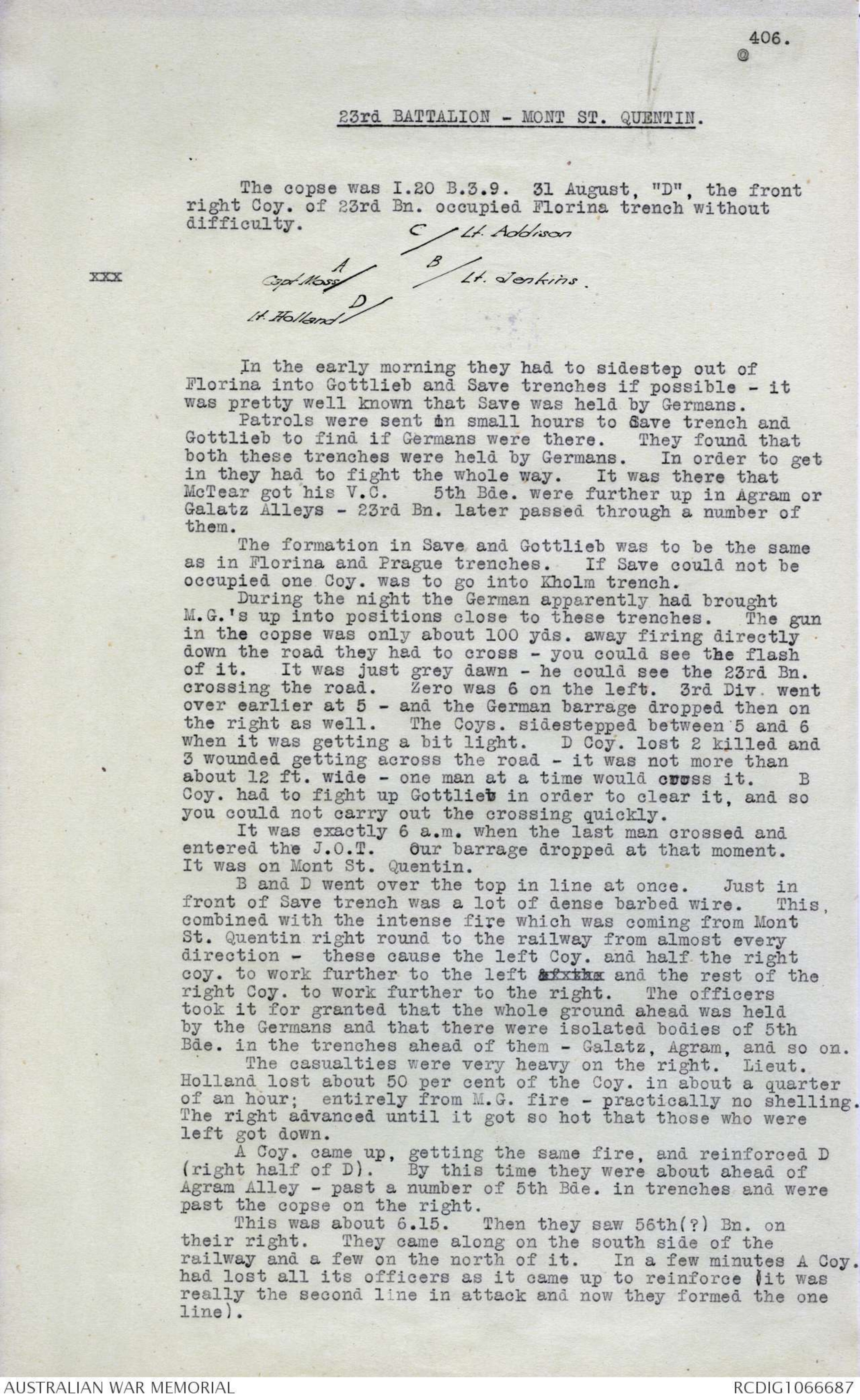
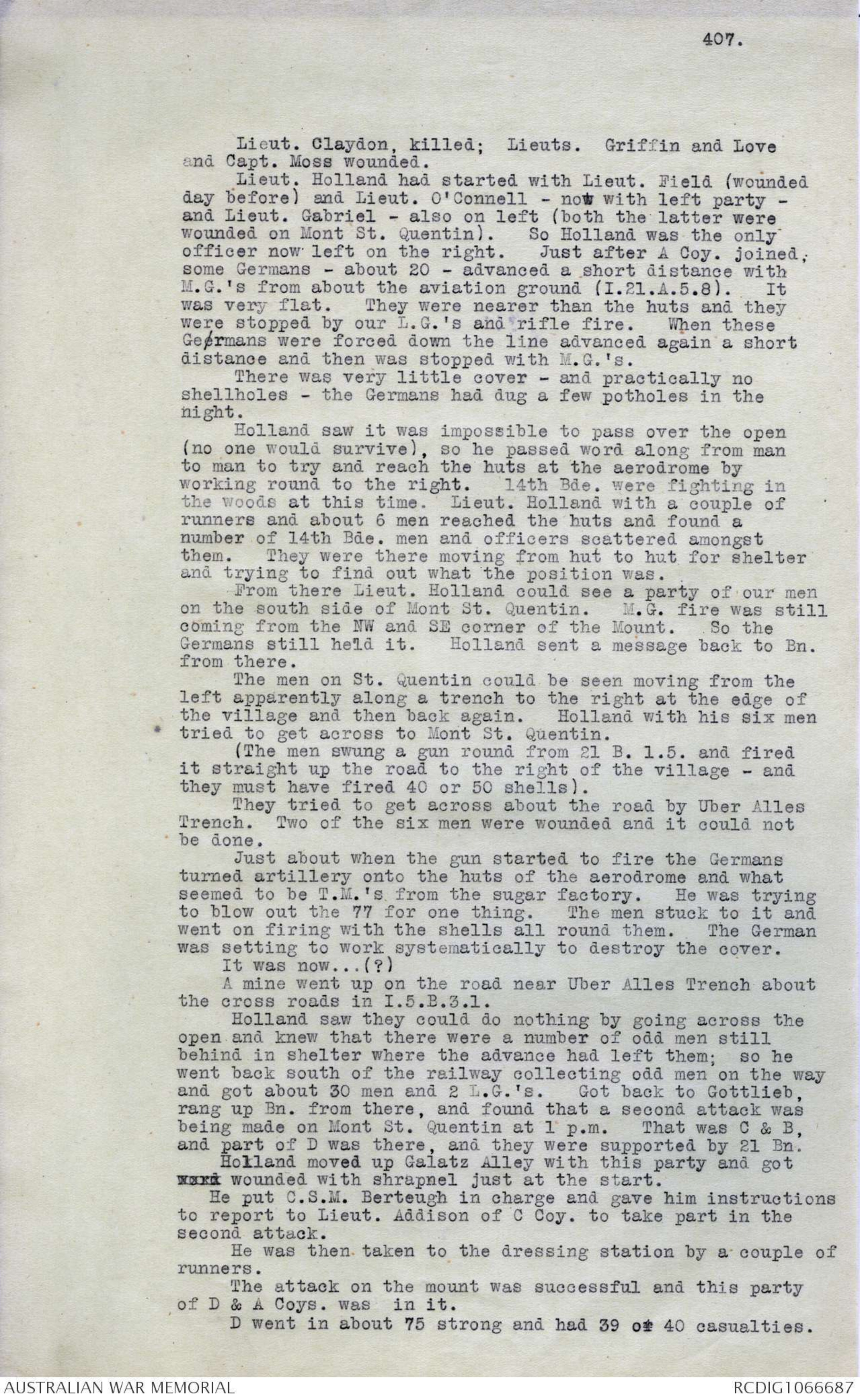
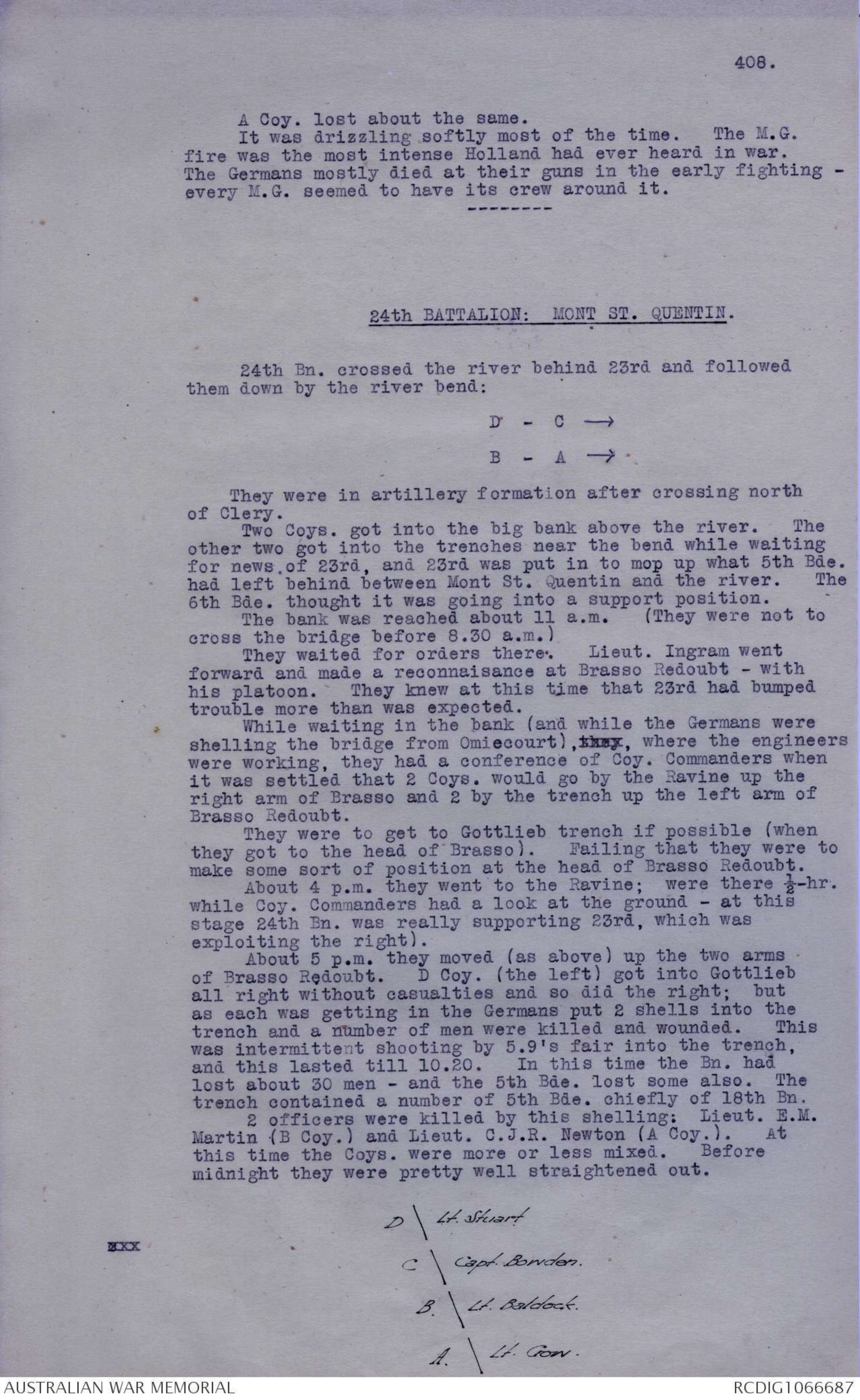
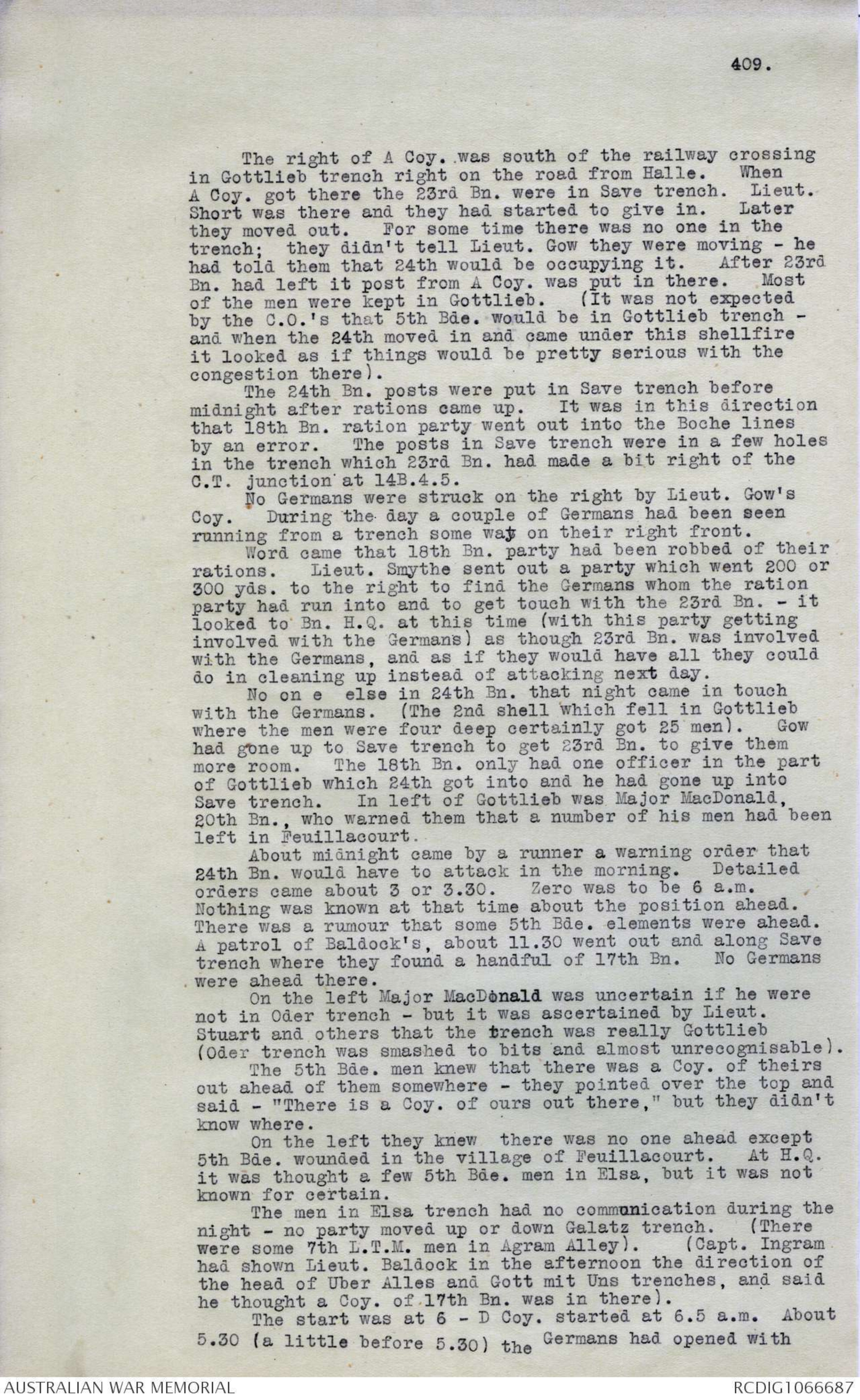
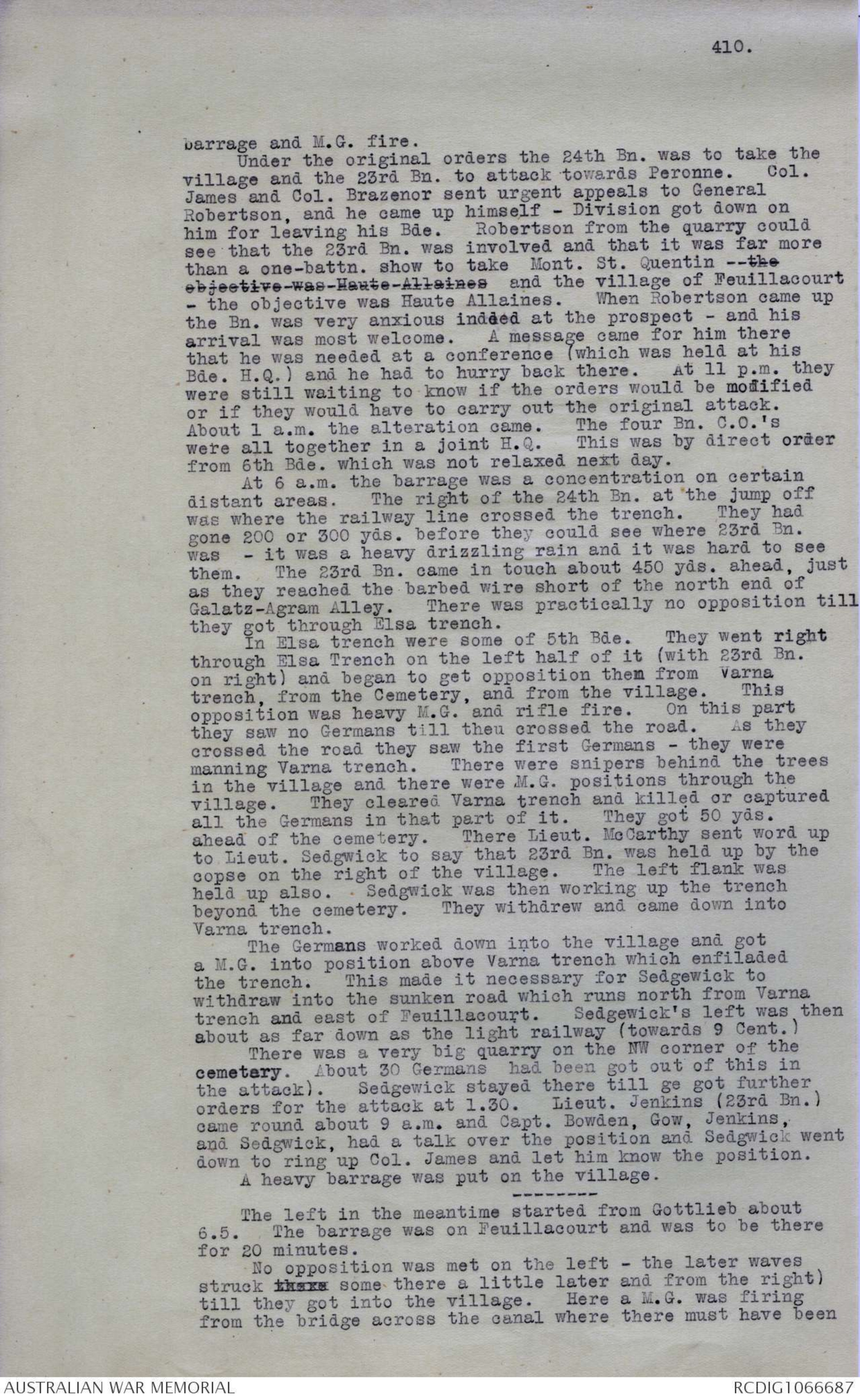
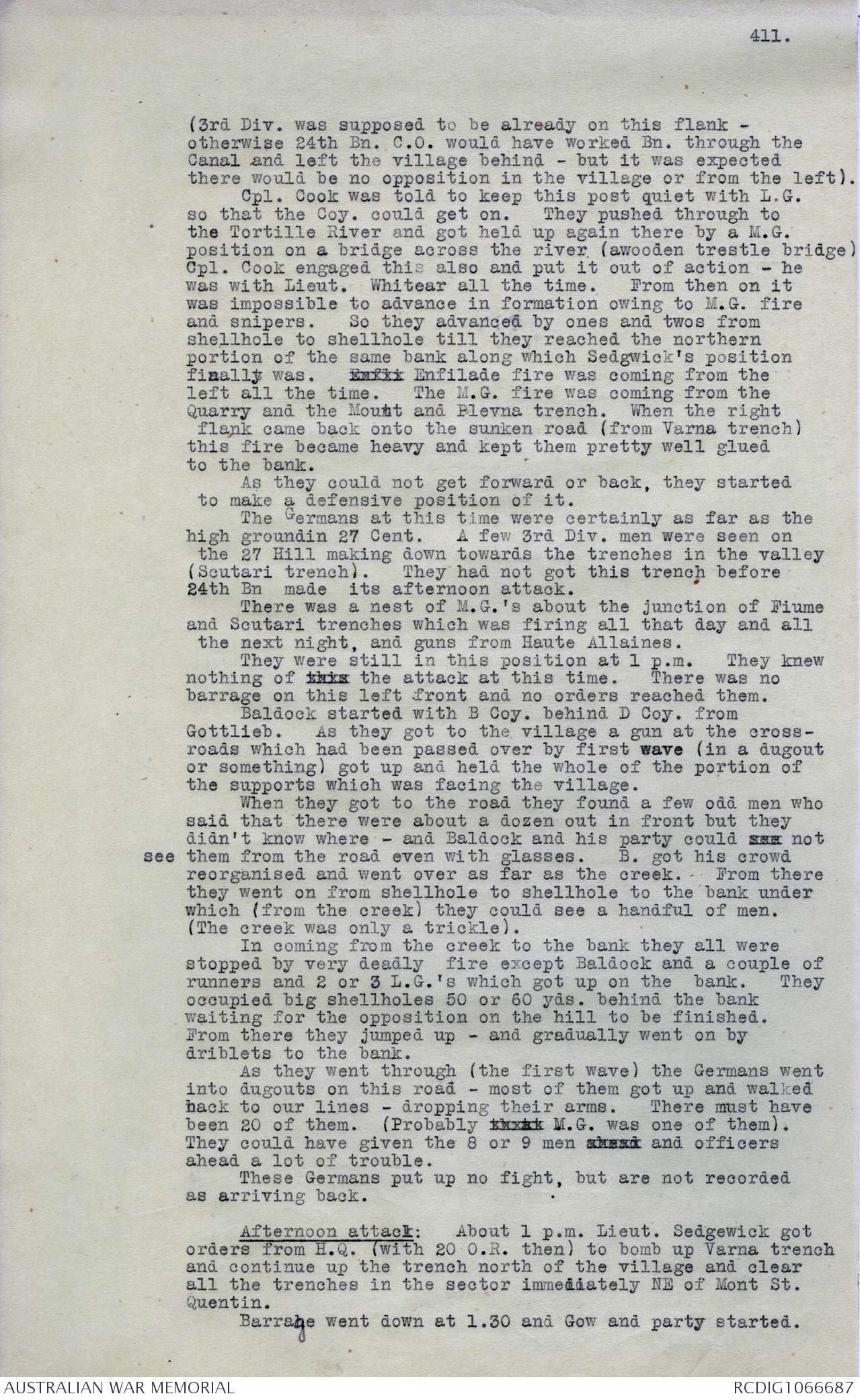
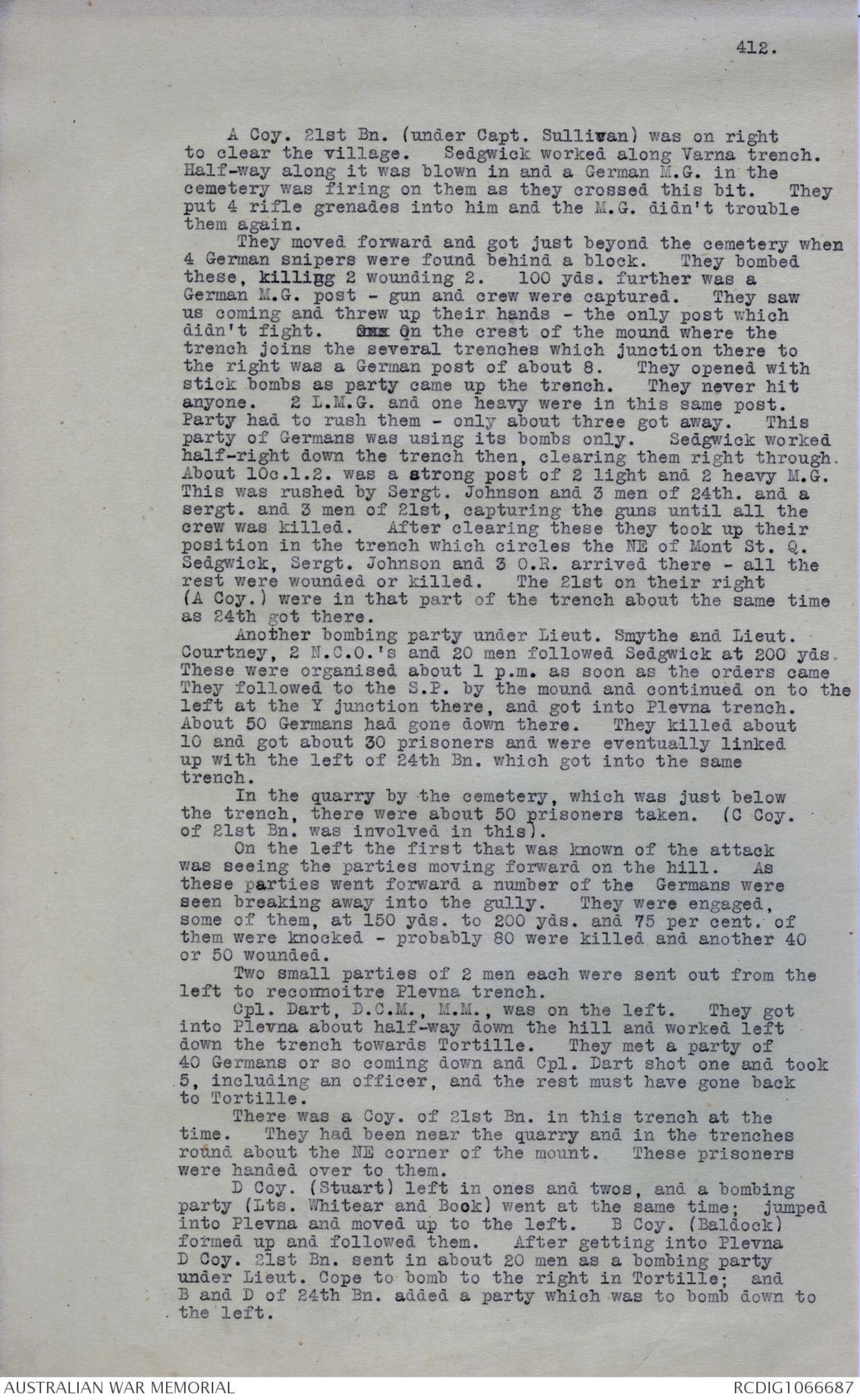
20. 404
and signallers, who worked straight on -- and Maj.
Matthews stayed on with the Americans.
Many Germans were killed in this fighting and Bn.
took more prisoners than it had casualties.
6th Bde. were the first Australian troops in the
line in France (?) and were the last out of it.
"To Captain Bean.
"Major Matthews, D.S.O. has suggested that I make a note
here bringing your notice that from the beginning
of August to October 1/Col. Wiltshire was commanding
the battalion continually in the front line without a
second in command and without relief. Major Matthews
was away for this period at the Senior Officers'
School, Aldershot."
(Sd) Eugene Gorman, Lt.
22nd A.I.F."
20th BATTALION - POZIERES.
On July 26th 1916 when 20th Bn. went into Sausage
Gully a message came from Bde. at 5 or 6 p.m. that
they would have to attack that night. They had no time
to see the place. Col. Ralston and McCall (Adjutant)
led the Bns. up and called in at 12th Bn. to H.Q. They
had been told to attack at midnight, between the main
road and the railway, against O.G.1; and if they got
on they were to send a second party through to O.G.2
They knew nothing of the place so they asked Elliott
and he said he would show them. He took them up Copse
Avenue - the Bn. following. In Copse Avenue he stood
on the top and showed McCall and Ralston the Copse and
arranged the flares and where the railway was and pointed;
"If you go in that direction for 400 or 500 yards you
come to the German trenches," he said, "you may find a
line of our men out a bit ahead of the Copse, but it is
not certain" (or something to that effect).
Ralston and McCall came back to the men of their 2
Coys. (only 2 Coys. were there) in Copse Avenue. The
men had not bombs. McCall had to find out where a dump
was. He found that there was one at the Quarry. He
came back and took down a party to carry up bombs; when
they were issued it was found that some were not detonated
-- and so every one had to be looked at. It was now 12 pm.
There zero was at that hour. The artillery was to continue
its ordinary night shooting and then go off O.G.1 at
12 o'clock so as to let the attack get in - and it was
doing this now. Ralston set Bde. and said that
he could not possible do the attack. He wanted it
postponed altogether - if he did it, he could not do it
before 3 a.m. The answer was that it was to be done at
3.
Ralston and McCall then organised the Bn. into 3
attacking Coys. with one carrying wire. They led them
out into position a little E. of Copse. At 3 a.m.
405
21.
the 3 parties moved out, more or less in single file.
They [[xxxxxxcrossed out]] headed towards the German trench.
About 100 yards or more out, there was a tree growing.
Ralston and McCall were with the centre party -
Ralston took it that this tree would ve a pretty good
mark - recognisable for Bn. H.Q. so they dropped into
a shell hole by it and the Bn. went on past them.
Presently the flares began to increase; then M.Gs.
Then the sound and flash of bombs. The party got
through the wire - the other two could not find a gap
(so it is said), and wandered up and down it. The
centre party got in - Harper was hit on the head by a
bomb and lay on the parapet directing operations.
Then the Germans began to bomb down from either flank -
and at last was nothing to be done but for the
party which was in to get out. They did so - and
brought in Harper.
The H.Q. party in the shell hole had all been hit
by now except Ralston - by bits of shell. A man
presently came running by in the dark calling for Bn.
H.Q. They dragged him in. He said that the attack
was no good - it had failed. Then men were seen
coming back through the dark - and all went back into
Copse Alley. The C.O. went Bde. to report.
McCall and the others did not know if they were in view
of the German at Copse Avenue, so they kept the two Coys.
in Copse Avenue the whole of the march back and thence
into Black Watch Alley where the 19th (? 17) Bn. was
just coming in and they had to file over the men lying
in the trench - a horrible congestion. So they got
out to Sausage Valley.
Next came the big bomb fight when the whole bombing
platoon went out; then came the attack of 28/29th July
when they had very much the same task as on July 26;
August 4th. When they got in they found no one on their
right at all in O.G.2. O.G.2 was about 20 yards this
side of a tree on the railway line - they only knew it
by some broken wire and a slight depression in the
ground. The 17th was in O.G.1 but not O.G.2 (on the
right of 20th Bn.) Burnell of the engineers this day
won his M.C. by crawling on his belly down O.G.2 from
right of 20th Bn. to Munster Alley. There were not
Germans in it.
On August 4th the 18th and 20th Bns. were to go in
by Walkers Avenue, not Copse Avenue.
? 7th Bde. by Copse Avenue and Enen Avenue.
? 6th Bde. by centre way.
The 18th Bn. all got to their J.O.T. on time; but
of 20th Bn. only the first Coy. was in when the barrage
fell. The junior officers had simply to lead their
companies straight out over from Walkers trench.
This happened with every brigade).
-----------------
405A.
23rd Bn. - MONT ST. QUENTIN.
----------
21st BATTALION
24th BATTALION:
BEAUREVOIR
MONT ST. QUENTIN
MONTBREHAIN.
(21st and 24th. from almost all the surviving officers
many N.C.O.'s).
406
23rd BATTALION - MONT ST. QUENTIN.
The copse was I.20 B.3.9. 31 August, "D", the front
right Coy. of 23rd Bn. occupied Florina trench without
difficulty. C/Lt. Addison
A/ B/Lt. Jenkins
Capt Moss/
D/Lt. Holland
In the early morning they had to sidestep out of
Florina into Gottlieb and Save trenches if possible - it
was pretty well known that Save was held by Germans.
Patrols were sent in small hours to Save trench and
Gottlieb to find if Germans were there. They found that
both these trenches were held by Germans. In order to get
in they had to fight the whole way. It was there that
McTear got his V.C. 5th Bde. were further up in Agram or
Gelatz Alleys - 23rd Bn. later passed through a number of
them.
The formation in Save and Gottlieb was to be the same
as in Florina and Prague trenches. If Save could not be
occupied by one Coy. was to go into Kholm trench.
During the night the German apparently had brought
M.G.'s up into positions close to these trenches. The gun
in the copse was only about 100 yds. away firing directly
down the road they had to cross - you could see the flash
of it. It was just grey dawn - he could see the 23rd Bn.
crossing the road. Zero was 6 on the left. 3rd Div went
over earlier at 5 - and the German barrage dropped then on
the right as well. The Coys. sidestepped between 5 and 6
when it was getting a bit light. D Coy. lost 2 killed and
3 wounded getting across the road - it was not more than
about 12 ft. wide - one man at a time would cross it. B
Coy. had to fight up Gottlieb in order to clear it, and so
you could not carry out the crossing quickly.
It was exactly 6 a.m. when the last man crossed and
entered the J.O.T. Our barrage dropped at that moment.
It was on Mont St. Quentin.
B and D went over the top in line at once. Just in
front of Save trench was a lot of dense barbed wire. This
combined with the intense fire which was coming from Mont
St. Quentin right round to the railway from almost every
direction - these cause the left Coy. and half the right
coy. to work further to the left [[xxxxxcrossed out]] and the rest of the right Coy. to the right. The officers
took it for granted that the whole ground ahead was held
by the Germans and that there were isolated bodies of 5th
Bde. in the trenches ahead of them - Galatz, Agram, and so on.
The casualties were very on the right. Lieut.
Holland lost about 50 per cent of the Coy. in about a quarter
of an hour; entirely from M.G. fire - practically no shelling.
The right advanced until it got so hot that those who were
left got down
A Coy. came up, getting the same fire, and reinforced D
(right half of D). By this time they were about ahead of
Agram Alley - past a number of 5th Bde. in trenches and were
past the copse on the right.
This was about 6.15. Then they saw 56th (?) Bn. on
their right. They came along on the south side of the
railway and a few on the north of it. In a few minutes A Coy.
had lost all its officers as it came up to reinforce it was
really the second line in attack and now they formed the one
line).
407.
Lieut. Clayton , killed; Lieuts. Griffin and Love and Capt. Mose wounded.
Lieut. Holland had started with Lieut. Field (wounded
day before) and Lieut. O'Connell - now with left party -
and Lieut. Gabriel - also on left (both the latter were
wounded on Mont St. Quentin). So Holland was the only
officer now left on the right. Just after A Coy. joined,
some Germans - about 20 - advanced a short distance with
M.G.'s from about the aviation ground (I21.A.5.8). It
was very flat. They were nearer than the huts and they
were stopped by our L.G.'s and rifle fire. When these
Geermans were forced down the line advanced again a short
distance and then was stopped with M.G.'s.
There was very little cover - and practically no
shellholes - the Germans had dug a few potholes in the
night.
Holland saw it was impossible to pass over the open
(no one would survive), so he passed word along from man
to man to try and reach the huts at the aerodrome by
working round to the right. 14th Bde. were fighting in
the woods at this time. Lieut Holland with a couple of
runners and about 6 men reached the huts and found a
number of 14th Bde. men and officers scattered amongst
them. They were there moving from hut to hut for shelter
and trying to find out what the position was.
From there Lieut. Holland could see a party of our men
on the south side of Mont St. Quentin. M.G. fire was still
coming from the NW and SE corner of the Mount. So the
Germans still held it. Holland sent a message back to Bn.
from there.
The men on St. Quentin could be seen moving from the
left apparently along a trench to the right at the edge of
the village and then back again. Holland with his six men
tried to get across to Mont St. Quentin.
(The men swung a gun round from 21 B. 1. 5. and fired
it straight up the road to the right of the village - and
they must have fired 40 or 50 shells).
They tried to get across about the road by Uber Alles
Trench. Two of the six men were wounded and it could not
be done.
Just about when the gun started to fire the Germans
turned artillery onto the huts of the aerodrome and what
seemed to be T.M.'s from the sugar factory. He was trying
to blow out the 77 for one thing. The men stuck to it and
went on firing with the shells all round them. The German
was setting to work systematically to destroy the cover.
It was now....(?)
A mine went up on the road near Uber Alles Trench about
the cross roads in I.5.B.3.1.
Holland saw they could do nothing by going across the
open and knew that there were a number of odd men still
behind in shelter where the advance had left them; so he
went back south of the railway collecting odd men on the way
and got about 30 men and 2 L.G.'s. Got back to Gottlieb,
rang up Bn. from there, and found that a second attack was
being made on Mont St. Quentin at 1 p.m. That was C & B,
and part of D was there, and they were supported by 21 Bn.
Holland moved up Galatz Alley with this party and got
[[xxxxcrossed out]] wounded with shrapnel just at the start.
He put C.S.M. Bertough in charge and gave him instructions
to report to Lieut. Addison of C Coy. to take part in the
second attack.
He was then taken to the dressing station by a couple of
runners.
The attack on the mount was successful and this party
of D & A Coys. was in it.
D went in about 75 strong and had 39 or 40 casualties.
408.
A Coy. lost about the same.
It was drizzling softly most of the time. The M.G.
fire was the most intense Holland had ever heard in war.
The Germans mostly died at their guns in the early fighting -
every M.G. seemed to have its crew around it.
--------------
24TH BATTALION: MONT ST. QUENTIN.
24th Bn. crossed the river behind 23rd and followed
them down by the river bend:
D - C →
B - A →
They were in artillery formation after crossing north
of Clery.
Two Coys. got into the big bank above the river. The
other two got into the trenches near the bend while waiting
for news of 23rd, and 23rd was put in to mop up what 5th Bde.
had left behind between Mont St. Quentin and the river. The
6th Bde. thought it was going into a support position.
The bank was reached about 11 a.m. (They were not to
cross the bridge before 8.30 a.m.)
They waited for orders there. Lieut. Ingram went
forward and made a reconnaisance at Brasso Redoubt - with
his platoon. They knew at this time that 23rd had bumped
trouble more than was expected.
While waiting in the bank (and while the Germans were
shelling the bridge from Omiecourt), [[xxxxcrosed out]], where the engineers were working, they had a conference of Coy. Commanders when it was settled that 2 Coys. would go by the Ravine up the
right arm of Brasso and 2 by the trench up the left arm of
Brasso Redoubt.
They were to get to Gottlieb trench if possible (when
they got to the head of Brasso). Failing that they were to
make some sort of position at the head of Brasso Redoubt.
About 4 p.m. they went to the Ravine; were there ½-hr.
while Coy. Commanders had a look at the ground - at this
stage 24th Bn. was really supporting 23rd, which was
exploiting the right).
About 5 p.m. they moved ( as above) up the two arms
of Brasso Redoubt. D Coy. (the left) got into Gottlieb
all right without casualties and so did the right; but
as each was getting in the Germans put w shells into the
trench and a number of men were killed and wounded. This
was intermittent shooting by 5.9's fair into the trench,
and this lasted till 10.20. In this time the Bn. had
lost about 30 men - and the 5th Bde. chiefly of 18th Bn.
2 officers were killed by this shelling; Lieut. E.M.
Martin (B Coy.) and Lieut. C.J.R. Newton (A Coy.). At
this time the Coys. were more or less mixed. Before
midnight they were pretty well straightened out.
D\ Lt. Stuart
C\ Capt. Bowden
B\ Lt. Baldock.
A\ Lt. [[Gow?]]
409
The right of A Coy. was south of the railway crossing
in Gottlieb trench right on the road from Halle
. When
A Coy. got there the 23rd Bn. were in Save trench. Lieut.
Short was there and they had started to give in. Later
they moved out. For some time there was no one in the
trench; they didn't tell Lieut. Gow they were moving - he
had told them that 24th would be occupying it. After 23rd
Bn. had left it post from A Coy. was put in there. Most
of the men were kept in Gottlieb. (It was not expected
by the C.O.'s that 5th Bde. would be in Gottlieb trench -
and when the 24th moved in and came under this shellfire
it looked as if things would be pretty serious with the
congestion there).
The 24th Bn. posts were put in Save trench before
midnight after rations came up. It was in this direction
that the 18th Bn. ration party went out into the Boche lines
by an error. The posts in Save trench were in a few holes
C.T. junction at 14B.4.5.
No Germans were struck on the right by Lieut. Gow's
Coy. During the day a couple of Germans had been seen
running from a trench some way on their right front.
Word came that 18th Bn. party had been robbed of their
rations. Lieut. Smythe sent out a party which went 200 or
300 yds. to the right to find the Germans whom the ration
party had run into and to get touch with the 23rd Bn. - it
looked to Bn. H.Q. at this time (with this party getting
involved with the Germans) as though 23rd Bn. was involved
with the Germans, and as if they would have all they could
do in cleaning up instead of attacking next day.
No on e else in 24th Bn. that night came in touch
with the Germans. (The 2nd shell which fell in Gottlieb
where the men were four deep certainly got 25 men). Gow
had gone up to Save trench to get 23rd Bn. to give them
more room. The 18th Bn. only had one officer in the part
of Gottlieb which 24th got into and he had gone up into
Save trench. In left of Gottlieb was Major MacDonald,
20th Bn.,who warned them that a number of his men had been
left in Feuillacourt.
About midnight came by a runner a warning order that
24th Bn. would have to attack in the morning. Detailed
orders came about 3 or 3.30. Zero was to be 6 a.m.
Nothing was known at the time about the position ahead.
There was a rumour that some 5th Bde. elements were ahead.
A patrol of Baldock's about 11.30 went out and along Save
trench where they found a handful of 17th Bn. No Germans
were ahead there.
On the left Major MacDonald was uncertain if he were
not in Oder trench - but it was ascertained by Lieut.
Stuart and others that the trench was really Gottlieb
(Oder trench was smashed to bits and almost unrecognisable).
The 5th Bde. men knew that there was a Coy. of theris
out ahead of them somewhere - they pointed over the top and
said - "There is a Coy. of ours out there," but they didn't
know where.
On the left they knew there was no one ahead except
5 Bde. wounded in the village of Feuillacourt. At H.Q.
it was thought a few 5th Bde. men in Elsa, but it was not
known for certain.
The men in Elsa trench had no communication during the
night - no party moved up or down Galatz trench. (There
were some 7th L.T.M. men in Agram Alley). (Capt. Ingram
had shown LIeut. Baldock in the afternoon the direction of
the head of Ube Alles and Cott mit Uns trenches, and said
he thought a Coy. of 17th Bn. was in there).
The start was at 6 - D Coy. started at 6.5 a.m. About
5.30 (a little before 5.30) the Germans had opened with
410.
barrage and M.G. fire.
Under the original orders the 24th Bn. was to take the
village and the 23rd Bn. to attack towards Peronne. Col.
James and Col. Brazenor sent urgent appeals to General
Robertson, and he came up himself - Division go down on
him for leaving his Bde. Robertson from the quarry could
see that the 23rd Bn. was involved and that it was far more
than a one=battn. show to take Mont St. Quentin -- the
objective was Haute Allaines and the village of Feuillacourt
--the objective was Haute Allaines. When Robertson came up
the Bn. was very anxious indeed at the prospect - and his
arrival was most welcome. A message came for him there
that he was needed at a conference (which was held at his
Bde. H.Q.) and he had to hurry back there. At 11 p.m. they
were still waiting to know if the orders would be modified
or if they would have to carry our the original attack.
About 1 a.m. the alteration came. The four Bn. C.O.'s
were all together in a joint H.Q, This was by direct order
from 6thBde. which was not relaxed next day.
At 6 a.m. the barrage was a concentration on certain
distant areas. The right of the 24th Bn. at the jump off
was where the railway line crossed the trench. They had
gone 200 or 300 yds. before they could see where 23rd Bn.
was - it was a heavy drizzling rain and it was hard to see
them. The 23rd Bn. came in touch about 450 yds. ahead, just
as they reached the barbed wire short of the north end of
Galatz-Agram Alley. There was practically no opposition till
they got through Elsa trench.
In Elsa trench were some of 5th Bde. They went right
through Elsa Trench on the far left of it (with 23rd Bn.
on right) and began to get opposition then from Varna
trench, from the Cemetery, and from the village. This
opposition was heavy M.G. and rifle fire. On this part
they saw no Germans till then crossed the road. As they
crossed the road they saw the first Germans - they were
manning Varna trench. There were snipers behind the trees
in the village and there were M.G. positions through the
village. They cleared Varna trench and killed or captured
all the Germans in that part of it. They got 50 yds.
ahead of the cemetery. There Lieut. McCarthy sent word up
to Lieut. Sedgwick to say that23rd Bn. was held up by the
copse on the right of the village. The left flank was
held up also. Sedgwick was then working up the trench
beyond the cemetery. They withdrew and came down into
Varna trench.
The Germans worked down into the village and got
a M.G. into position above Varna trench which enfiladed
the trench. This made it necessary for Sedgwick to
withdraw into the sunken road which runs north from Varna
trench and east of Feuillacourt. Sedgwick's left was then
about as far down as the light railway (towards 9 cent.)
There was a very big quarry on the NW corner of the
cemetery. About 30 Germans had been got out of this in
the attack). Sedgwick stayed there till ge got further
orders for the attack at 1.30. Lieut. Jenkins (23rd Bn.)
came round about 9 a.m. and Capt. Bowden, Gow, Jenkins,
and Sedgwick, had a talk over the position and Sedgwick went
down to ring up Col. James and let him know the position.
A heavy barrage was put on the village.
-----------
The left in the meantime started from Gottlieb about
6.5. The barrage was on Feuillacourt and was to be there
for 20 minutes.
No opposition was met on the left - the later waves
struck [[xxxxcrossed out]] some there a little later and from the right) till they got into the village. Here a M.G. was firing
from the bridge across the canal where there must have been
411.
(3rd Div. was supposed to be already on this flank -
otherwise 24th Bn. C.O. would have worked Bn. through the
Canal and left the village behind - but it was expected
there would be no opposition in the village or from the left).
Cpl . Cook was told to keep this post quiet with L.G.
so that the Coy. could get on. They pushed through to
the Tortille River and got held up again there by a M.G.
position on the bridge across the river (awooden trestle bridge)
Cpl. Cook engaged ithis also and put it out of action - he
was with Lieut. Whitear all the time. From then on it
was impossible to advance in formation owing to M.G. fire
and snipers. So they advanced by ones and twos from
shellhole to shellhole till they reached the northern
portion of the same bank along which Sedgwick's position
finally was. [[xxxxxcrossed out]] Enfilade fire was coming from the
left all the time. The M.G. fire was coming from the
Quarry and the Mount and Plevna trench. When the right
flank came back onto the sunken road (from Varna trench)
this fire became heavy and kept them pretty well glued
to the bank.
As they could not get forward or back, they started
to make a defensive position of it.
The Germans at this time were certainly as far as the
high groundin 27 Cent. A few 3rd Div. men were seen on
the 27 Hill making down towards the trenches in the valley
(Soutari trench). They had not got this trench before
24th Bn made its afternoon attack.
There was a nest of M.G.'s about the junction of Fiume
and Soutari trenches which was firing all that day and all
the next night, and guns from Haute Allaines.
They were still in this position at 1 p.m. They knew
nothing of [[xxxcrossed out]] the attack at this time. There was no barrage on this left front and no orders reached them.
Baldock started with B Coy. behind D Coy. from
Gottlieb. As they got to the village a gun at the cross-
roads which had been passed over by first wave (in a dugout
or something) got up and held the whole of the portion of
the supports which was facing the village.
When they got to the road they found a few odd men who
said that there were about a dozen out in front but the
didn't know where - and Baldock and his party could [[xxxxcrossed out]] not see them from the road even with glasses. B got his crowd
reorganised and went over as far as the creek. From there
they went on from shellhole to shellhole to the bank under
which (from the creek) they could see a handful of men.
(The creek was only a trickle).
In coming from the creek to the bank they all were
stopped by very deadly fire except Baldock and a couple of
runners and 2 or 3 L.G.'s which got up on the bank. They
occupied big shellholes 50 or 60 yds. behind the bank
waiting for the opposition on the hill to be finished.
From there they jumped up - and gradually went on by
driblets to the bank.
As they went through (the first wave) the Germans went
into the dugouts on this road -most of them got up and walked
back to our lines -dropping their arms. There must have
been 20 of them. (Probably [[xxxx crossed out]] M.G. was one of them). They could have given the 8 or 9 men [[xxxx crossed out]] and officers ahead a lot of trouble.
These Germans put up no fight, but are not recorded
as arriving back.
Afternoon attack: About 1 p.m. Lieut. Sedgwick got
orders from H.Q. (with 20 O.R. then) to bomb up Varna trench
and continue up the trench north of the village and clear
all the trenches in the sector immediately NE of Mont St.
Quentin.
Barrages went down at 1.30 and Gow and party started
412.
A Coy. 21st Bn. (under Capt. Sullivan) was on right
to clear the village. Sedgwick worked along Varna trench.
Half-way along it was blown in and a German M.G. in the
cemetery was firing on them as they crossed this bit. They
put 4 rifle grenades into him and the M.G. didn't trouble
them again.
They moved forward and got just beyond the cemetery when
4 German snipers were found behind a block. They bombed
these, killing 2 wounding 2. 100yds. further was a
German M.G. post - gun and crew were captured. They saw
us coming and threw up their hands - the only post which
didn't fight. [[xxx crossed out]] On the crest of the mound where the
trench joins the several trenches which junction there to
the right was a German post of about 8. They opened with
stick bombs as party came up the trench. They never hit
anyone. 2 L.M.G. and one heavy were in this same post.
Party had to rush them - only about three got away. This
party of Germans was using its bombs only. Sedgwick worked
half-right down the trench then, clearing them right through.
About 10c.1.2. was a strong post of 2 light and 2 heavy M.G.
This was rushed by Sergt. Johnson and 3 men of 24th. and a
sergt. and 3 men of 21st, capturing the guns until all the
crew was killed. After clearing these they took up their
position in the trench which circles the NE of Mont. St. Q.
Sedgwick, Sergt. Johnson and 3 O.R. arrived there- all the
rest were wounded or killed. The 21st on their right
(A Coy.) were in that part of the trench about the same time
as 24th got there.
Another bombing party under Lieut. Smythe and Lieut.
Courtney, 2 N.C.O.'s and 20 men followed Sedgwick at 200 yds.
These were organised about 1 p.m. as soon as the orders came
They followed to the S.P. by the mound and continued on to the
left at the Y junction there, and got into Plevna trench.
About 50 Germans had gone down there. They killed about
10 and got about 30 prisoners and were eventually linked
up with the left of 24th Bn. which got into the same
trench.
In the quarry by the cemetery, which was just below
the trench, there were about 50 prisoners taken. (C Coy.
of 21st Bn. was involved in this).
On the left the first that was known of the attack
was seeing the parties of 2 men each were sent out from the
left to reconnoitre Plevna trench.
Cpl. Dart, D.C.M. M.M., was on the left. They got
into Plevna about half-way down the hill and worked left
down the trench towards Tortille. They met a party of
40 Germans or so coming down and Cpl. Dart shot one and took
5, including an officer, and the rest must have gone back
to Tortille.
There was a Coy. of 21st Bn. in this trench at the
time. They had been near the quarry and in the trenches
round about the NE corner of the mount. These prisoners
were handed over to them.
D Coy. (Stuart) left in ones and twos, and a bombing
party (Lts. Whitear and Book) went at the same time; jumped
into Plevna and moved up to the left. B Coy. (Baldock)
formed up and followed them. After getting into Plevna
D Coy. 21st Bn. sent in about 20 men as a bombing party
under Lieut. Cope to bomb to the right in Tortille; and
B and D of24th Bn. added a party which was to bomb to
the left.
 Sam scott
Sam scottThis transcription item is now locked to you for editing. To release the lock either Save your changes or Cancel.
This lock will be automatically released after 60 minutes of inactivity.